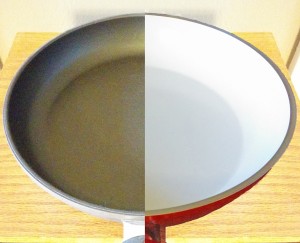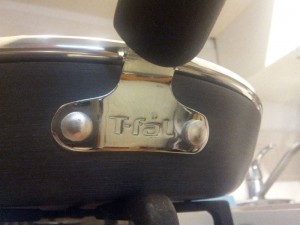Cookware sets called “15 piece”, “12 piece”, or “10 piece”, really just have 5 or 6 pieces of actual cookware. The sets also include a few lids, and the rest of the “piece” count is filled out with plastic utensils or other small accessories. That’s fine, lids and utensils are important, but you want to compare the various sets on an apples to apples basis. That’s where our guide to the best nonstick cookware comes in.
Besides piece count, the other crucial feature of nonstick cookware that can be very confusing is the type of nonstick coating. Brands love to make up their own fancy names for their coatings. But the fact is all nonstick coatings fall into one of two categories: PTFE, and ceramic. We here at Love Low Fat use both PTFE and ceramic. For details see our in depth explanation of coating types below the guide.
Column titles are explained at the bottom of the guide. You can sort the table the way you like by clicking on any column header. For example you can sort the table by price, number of pieces, or type of nonstick coating:
The 7 columns in the guide are:
- Cookware set name & picture (click to view more details or to purchase)
- Number of actual cookware pieces, and number of covers
- Price – These are current prices on Amazon.com in U.S. dollars. Outside the U.S., click the price in dollars to see the price in your local currency. In some cases prices will be different depending on color and/or style.
- Type of nonstick coating (more on coating materials below)
- Whether the set is dishwasher safe
- Color options
- Rating – This is the average user rating on Amazon.com. It can be very helpful in deciding whether people were satisfied with their purchase.
Nonstick Coating Materials
The type of nonstick coating is very important to some people. Some brands are very up front about what their coating is made from, and some are less up front. But all nonstick cookware currently widely available falls into one of two categories, PTFE or ceramic.
PTFE cookware
PTFE is the “classic” nonstick material made famous by the brand Teflon. While it is extremely functional, some are concerned about its safety. When overheated, PTFE coatings can break down and release gases.
You can use PTFE cookware safely as long as you use it properly. 500ºF is the maximum temperature recommended for cooking with PTFE cookware.
If you own birds, you may want to avoid PTFE cookware. Birds are much more sensitive to PTFE fumes than humans are.
When baking, roasting or espcially broiling with PTFE cookware, make sure to check the manufacturers recommended maximum oven safe temperature. For stovetop cooking, keep the following tips in mind:
- Always cook on low to medium heat. Never cook with high heat.
- Never preheat an empty pan.
- If you’re not cooking with a broth or liquid that absorbs heat, pay close attention to your cooking surface. Foods that coat most of the pan’s surface will help keep temperatures down.
- Use extra care when using lightweight cookware. Lightweight pans heat faster than heavier pans.
- Pay attention while cooking. Never leave a pan unattended.
Some PTFE cookware is manufactured using a a chemical called PFOA. If you’re concerned about the environmental impact of your cookware, you want to avoid sets manufactured using PFOA. After reaching an agreement with the EPA, the major manufacturers of PTFE cookware are phasing out the use of PFOA completely by 2015. The Discovery Channel made an interesting short video on how PTFE cookware is made:
Ceramic cookware
Ceramic is a newer material in the world of nonstick cookware. It’s widely considered to be the safest and most environmentally friendly option. It’s free of PTFE and PFOA, and comes in a wide variety of styles and colors.
Some argue that it has a shorter life span than PTFE cookware. However cookware life span can be dramatically affected by your style of cooking.
If you cook with oil, it’s critical to completely clean off all of the cooked oil after each use. Otherwise layers of oil will build up, diminishing the nonstick properties of the cookware. But unfortunately if you vigorously scrub off the layers of oil, you inevitably take the nonstick surface with it. This can cause the cookware to age prematurely.
The easy way out of this conundrum is to not use oil. For this reason, and more importantly for health reasons, we recommend cooking without any oil at all.
Oil free cooking
We here at the nonstick cookware guide cook with no oil at all. We encourage you to give it a try! It is definitely different than cooking with oil. Some things cook faster, and some things cook slower. Once you get used to it, you’ll find that you can cook all the same foods just as deliciously as you can cooking with oil.
Cooking with oil is so widespread in modern western culture that many people have a hard time even conceiving of cooking without it. But it definitely can be done, and it can have a huge impact on your health (and also on the life of your cookware!).
Oil is 100% fat. The benefits of a low fat diet are widely documented. Eliminating oil from your cooking is an important component of a healthy diet.
Caring for your nonstick cookware
Always use bamboo or wooden utensils when cooking with nonstick cookware. Metal utensils will damage your cookware regardless of what some manufacturers claim.
Never use steel wool to clean your nonstick cookware. Clean your cookware with a natural sponge or soft plastic brush. Avoid stacking nonstick pans, as the metal bottoms can scratch the pan beneath. If you need to stack the pans due to lack of storage space, put a paper towel or other liner between them.
So what’s the best nonstick cookware set for you?
When you purchase a cookware set, you don’t want to have to think about purchasing more cookware any time soon. So it’s important think of it as an investment. First determine your price limit, then find the best quality set in that range that fits your needs.
The number of pieces you need depends on the type of foods you want to cook. If you like to cook multiple side dishes you will need a set with more pieces.
Depending how many people you’re cooking for, you should consider pan sizes. If you’re cooking for several people you’ll want larger pans. Smaller pans are more efficient if you’re cooking for just one or two.
If you’re cooking out of necessity, you want to focus on convenience. If you have a dishwasher, make sure the set you purchase is dishwasher safe. However, even if it is dishwasher safe, you will improve the longevity of the pan by washing it by hand.
If you’re cooking for pleasure, focus on features that will enhance your cooking experience. You may want extra pans or pots so that you can cook side dishes at the same time as the main course. You might want to focus on details like rubberized handles, or colored pans that you can display in your kitchen or while serving food.
Remember that if you can’t find the perfect set, you can always buy pans individually. Sets are usually more cost effective, but they don’t make sense if you’re getting things you’re not going to use. Ultimately the best nonstick cookware set for you might be a collection of many different brands, based on your specific needs.

























I HAVE A 8 INCH GREENWARE FRY PAN WHICH HAS BECOME A STICKING MESS . HOW DO YOU CURE THE SURFACE AFTER A 2 MONTH USE?
Hi Frank,
That’s a bummer. Not sure how to cure it since we haven’t yet experienced that. If soaking it in warm soapy water doesn’t do the trick, is it possible it is damaged? There are a number of factors that could cause damage to nonstick cookware such as overheating, metal utensils, washing it before it has cooled, using a dishwasher, etc. But if you have taken care of your pan properly, it might be covered by the manufacturer’s warranty. If you are talking about Cuisinart Greenware, their number for product inquiries is: 1-800-726-0190.
Good luck, Frank, and please let us know how it goes!
Best regards,
~Maria
I purchased ‘carbon steel non stick cookware sets’ from Brylane home . That was a waste of money. They were a gift to family members as well as myself and the first time I used them, my food stuck to the pans… needless to say, my family members complained that they are “NOT” non stick cookware… Many years ago when non stick cookware first came out… those were the “best” I cook with oil and I never had to spray my pans, they were the best. Unfortunately, I cant remember the name… and after searching for them online… I’m caught between t-fal and Cuisinart… I want “real non stick cookware” where my food will not stick at all.
Wonderful overview… thanks for sharing!
Thanks for the nice comment, Jenn!
Awesome cookware guide, just what I was looking for. So sick of food sticking to pans. Time to handle things.
Hello Maria & Ayal, I’m Anjelica. I was looking for a description about ceramic ceratinum for cookware use and I found your site. This is really good to know that you guys have a lot of guide of cooking and sharing your experience here. I really enjoy it 🙂
From my experience the scratch on teflon pan causes oil turn to black colour after it using for cooking. This is absolutely not good for health. So I think its better to use the ceramic cookware than teflon.
Thanks so much for your comment and input, Anjelica!
I personally prefer nonstick pans for regular cooking. However, some people talk about health issue. Are they safe? Thanks.
For nonstick, we prefer ceramic coated since they do not have PTFEs of PFOAs.
Hi. I am looking for a new set of cookware. I currently have t-fal but am tired of having to tighten the screws on the handles. I would like to try the ceramic kind. I have been looking at your website here and am not sure which one to get. Can you recommend a good set that doesn’t have handles that screw on? Thank you.
We’re not aware of any full sets that don’t have screws holding the handles. However we’ve had our Bialetti for years without the screws loosening, so perhaps it’s just the set that you have (or T-Fal in general)? Another approach might be to get individual pans rather than a set. Ozeri makes a 10″ ceramic pan with no bolts that looks pretty awesome, check it out here.
If you are tired of the screws holding the handles on coming loose then get some threadedlocker to solve the problem. Permanent threadlocker (also called red, and some other names) should fix it. It won’t cure if it is exposed to air. So you have to apply it to the threads and then tighten the screw very tight, to remove as much air as possible. Don’t over tighten the screw so much that it breaks off – that is a real headache and if you have red threadlocker on it you will never get it back out. It would have to be drilled out. Blue threadlocker allows you to remove the screw or bolt but with some difficulty and usually a lot of heat.
Rachael Ray 14-Piece Cookware Set looks so great. I hope this set will be better than my Rachael Ray Cucina Hard Porcelain Enamel Nonstick Cookware Set. It’s not dishwasher-safe so it makes me difficult to clean.